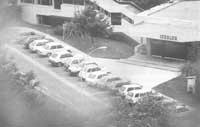Spatial structures: A Basque company among the best
1988/12/01 Aizpurua Sarasola, Joxerra Iturria: Elhuyar aldizkaria
Orona
Last April, the General Assembly held the Act of this company in 1987. The ORONA cooperative is part of the Regional Group ORBIDE, whose financial entity is Caja Laboral Popular.
In 1987 he made sales of 3,164 million pesetas and his staff is 448 people.
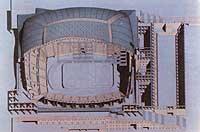
ORONA's activity is Elevation, Escalators and Spatial Structures. The technology used is of high level, both in products and in means of manufacture.
The direct consequence of this is reflected in the contracts. After competing with different companies, he has obtained contracts for the construction of the lifts of the Olympic Ring of Barcelona, the Olympic Stadium of Montjuit and the Sports Palace San Jordi on the one hand and the roof structure of the Sports Palace San Jordi on the other.
But this will not be the only spectacular work. There are the Seville Exhibition and the New Congress Centre, the San Pablo Sports Centre in Seville, etc.
San Jordi Sports Palace
The budget of this building, which will accommodate 17,000 people seated, amounts to 5,818 million pesetas. Of these, approximately 1 billion will be needed for ORONA to build the roof structure.
The structure has a length of 127.87 m, a width of 105.60 m and a height of 45 m. It occupies a total surface area of 13,462 m 2. It is based on 60 circular supports and only transmits vertical loads to the concrete structure. The supports are joined by pairs using lintels beams, so that they work as rigid porticos, giving them stability to the wind and steam.
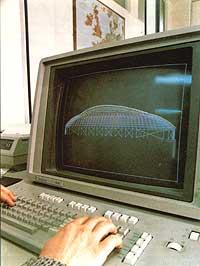
The main structure consists of a double layer spatial network. The average size of the bars is 3.6 m and the distance between the two layers of the network is 2.5 m.
The aspect of the structure leads the forces towards concrete environments. Therefore, in the early stages of calculation, the aim was to concentrate the forces on two pairs of rings, one on the transition edge that delimits the central dome and the other on the outside. The rings have been made with continuous curved tubes and welded 406 and 508 mm diameter respectively. Radial welded tube nerves have also been designed to join the outer and inner rings in the four corners of the cover.
Through these rings and nerves the most important forces of the deck are driven to the desired place. The structure is completed with a special screwed mesh. This network is formed following the ORTZ structural system and consists of pipes (such as force transmission elements) and spheres (such as joints).
Due to the different stresses, the tubes and spherical balls are of various sizes. The complete network consists of 2,343 joints and 9,070 bars. Geometric complexity has required the construction of bars of different length and spheres with holes of different orientation. Consequently, there are 1,500 different types of spheres and 3,200 different types of bars.
As for the diameter and thickness of the pipe wall, the changes are evident (see table).
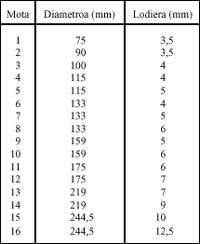
As for the spheres, their size is (mm): 100, 134, 150, 178, 210, 250.
The most resistant elements of the network can withstand an axial force of 200 tons. If so many dimensions have been used in bars or spheres, it is because in its manufacture automatic and computerized means are used, that is, CAD/CAM systems.

The manufacture of bars and spheres has been made in ORONA. To do this, the numerical control machine receives the information directly from the computer. In this way, the operator does not participate in fixing the manufacturing parameters, a flexible system is achieved that minimizes the probability of error.
For the calculation of any structure different load hypotheses must be taken into account, such as wind, snow, static loads, etc. Eleven different load hypotheses had to be taken into account for the calculation of this structure. It is known that when studying a structure based on different load hypotheses, the different load hypotheses are not studied only individually. Different combinations must be studied to take into account the most unfavorable conditions that the structure can withstand. Due to the long duration of this calculation process and the inability to interrupt the manufacturing process, ORONA left the computer working during nights and weekends.
This 950 ton structure has another very outstanding feature in ORONA, the narrow dimensional tolerance in the manufacture of bars and spheres. In the case of bars it has been 0.5 mm and in the case of spheres 0.1 mm. These margins of error are totally abnormal in the world of structures, but it has allowed to obtain such a complex geometric image.

Once the structure is designed and the parts are manufactured, the assembly is carried out. There are many ways to mount, but this very giant and curious structure is mounted with a spectacular system. The name of this system is "Pantadome" and M. Kawaguchi is the designer. As to see better than to say, between December/January will begin assembly and television cameras will not miss. Therefore, it can happen that while you are reading this article you can publicize the montage on TV.
However, the three photos from the previous page can help us to make a simple explanation of this system.
The bars and spheres are joined by a screw system. This allows the bars to be transported on one side and the spheres on the other. The bars and spheres are easily mounted on the site, as each bar and gap of the spheres are numbered. Numbering is related in the mounting planes. Therefore, assembly is done following these guidelines.
Bars and spheres need special layers of primer and paint to avoid oxidation problems. Since ORONA we have been told that they have had to pass very strict controls in this field.

Finally, we must say that: That ORONA has presented itself to this project with another company, DRAGADOS Y IES, through the temporary company DRAGORONA. DRAGADOS Y CONSTRUCCIONES has executed the lower or concrete part of the sports palace.
And now what?
At the beginning of this article it has been said that ORONA had to compete strongly with different companies. In particular, a German and a Japanese company competed. Each observed the technical errors or impediments of the other and there were political pressures.
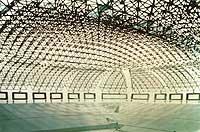
However, this Basque company was clear that in this project, along with the economic interest, there was also the most recognized prestige.
The fame acquired in Barcelona has facilitated its presentation elsewhere in the world. In Arabia, for example, they will have the opportunity to build several buildings. In Spain unique structures are also being developed, always within the space sphere.

Gai honi buruzko eduki gehiago
Elhuyarrek garatutako teknologia




